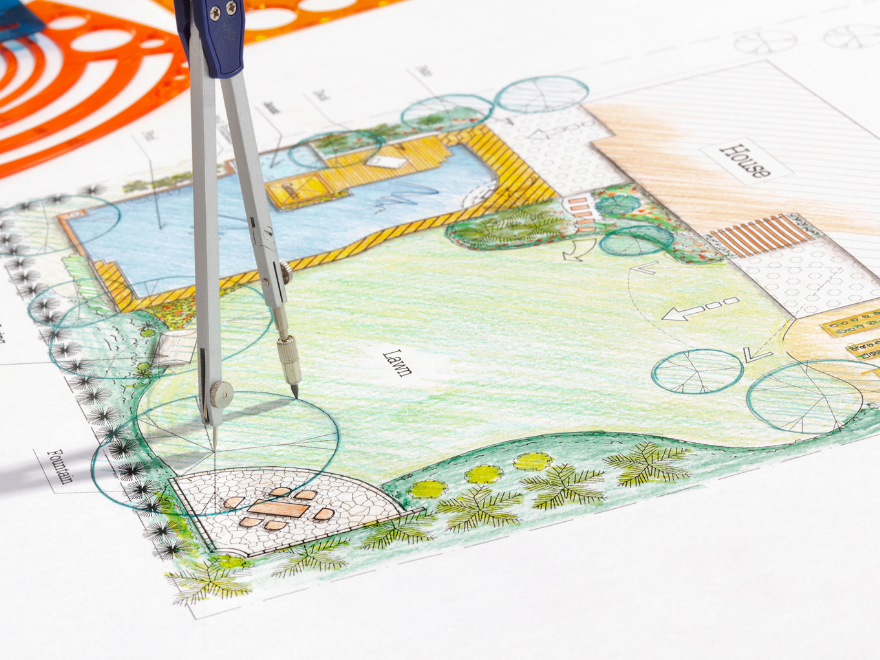Do You Need Planning Permission For Garden Design?

With summer approaching, many homeowners in the UK are excited to make changes to their gardens. From landscaping to building decking, garden offices, fences, or changing ground levels, numerous projects can enhance your outdoor space.However, it’s essential to understand planning permission requirements for various garden projects. This article delves into different garden projects and whether you need to consider obtaining permission before proceeding.
You generally do not need planning permission for garden design, as most landscaping and gardening activities are considered permitted development. However, if your project involves constructing large structures, altering ground levels significantly, or impacts listed buildings or conservation areas, you may require permission.
Let’s take a closer look at all the elements of garden design and what permissions could be required.
Understanding Permitted Development
Permitted Development (PD) is a concept in UK planning law that allows homeowners to carry out specific types of home and garden design work without obtaining planning permission[1]. PD has stringent requirements for each type of development, considering factors such as height, size, proximity to neighbouring properties, and proximity to main roads.
Before starting any garden project, it is crucial to understand whether your planned work falls under Permitted Development.
Walls, Fences, and Enclosures
Under Permitted Development, you can build, improve, maintain, or alter a fence, wall, or other enclosure[2]. There are restrictions:
- The height of the wall or fence must not exceed 1 metre if adjacent to a road.
- The height of any other wall, fence, gate, or other enclosure must not exceed 2 metres.
- You cannot carry out such work under Permitted Development if you live in a listed building[3].
If your proposed garden project involves constructing a wall, fence, or enclosure that exceeds these limitations or if you live in a listed building, you must apply for planning permission.
Sheds, Summerhouses, and Garden Offices
If you plan to add a shed for storage, a garden office, or a summer house, you may be able to do so under Permitted Development[4]. However, there are restrictions to consider. The total area of outbuildings must not exceed 50% of your total area of ‘curtilage,’ which refers to your garden space[5].
The 50% limit also includes any extension your home may have but does not encompass areas covered by the main building. If your proposed garden room exceeds the 50% limit, you will need to apply for planning permission.
Garden Decking
Garden decking generally does not require planning permission, provided you meet specific criteria[6]. The primary concern is that the decking platforms must not be more than 30cm from the ground. If your proposed decking exceeds this height restriction, you will need to seek planning permission.
Landscaping Projects
Typically, garden design projects such as re-turfing a lawn area, adding garden paving, or creating flower beds do not require planning permission[7]. The rules for walls, fences, and other enclosures have been outlined above. Typically, standard landscape lighting won’t require planning permission, but care has to be taken to not disturb neighbours. However, you should be cautious when pruning trees.
Certain types of trees are protected under Tree Preservation Orders (TPOs)[8], so it is advisable to check with your local council before cutting down or significantly pruning a tree. Before working on a TPO-protected tree, you must get permission from your local planning body.
Ground Level Changes
Changing the ground level of your garden might require planning permission, depending on the scale of the work and its potential impact on drainage, flooding, and neighbouring properties.
Consult your local planning office if your project includes major ground level changes in order to determine if planning approval is needed. They will consider factors such as the project’s potential impact on neighbouring properties, local ecology, and the risk of flooding.
Conclusion
Before embarking on any garden project in the UK, it is crucial to understand the planning permission requirements and whether your planned work falls under Permitted Development.
Always check local regulations and consult your local council for guidance to ensure your project proceeds smoothly and complies with the law. By following these guidelines and obtaining the necessary permissions, you can create a beautiful and functional outdoor space that adheres to the UK’s planning regulations.
Further Information
[1] Planning Portal – Permitted Development Rights: https://www.planningportal.co.uk/info/200125/do_you_need_permission/37/permitted_development_rights
[2] Planning Portal – Fences, gates and garden walls: https://www.planningportal.co.uk/info/200130/common_projects/20/fences_gates_and_garden_walls
[3] Historic England – Listed Buildings: https://historicengland.org.uk/advice/hpg/hpr-definitions/listedb/215378/
[4] Planning Portal – Outbuildings: https://www.planningportal.co.uk/info/200130/common_projects/43/outbuildings
[5] Planning Portal – Glossary – Curtilage: https://www.planningportal.co.uk/glossary/curtilage
[6] Planning Portal – Decking: https://www.planningportal.co.uk/info/200130/common_projects/11/decking
[7] Tree preservation orders & trees in conservation areas (GOV.UK): https://www.gov.uk/guidance/tree-preservation-orders-and-trees-in-conservation-areas
[8] Planning Portal – Planning Permission: https://www.planningportal.co.uk/info/200125/do_you_need_permission

